I grow enough garlic each year to feed all of Sicily, but it still never seems to be enough. Garlic is worth its weight in gold around these parts. I can’t give away even the finest specimens of my fancy heirloom squashes, no one gives a rat about my Striped Green Zebras or a fistful of my prized old timey bean pods or fragrant Holy Basil. But garlic?!
Our gutter guy will trade his hours for it. My neighbor, Sandy, calls to let me know she just needed to grab a few heads from the barn. My other neighbor (you know who you are) eyes it up and tells me a story about how his mother used to grow it and he hasn’t tasted fresh-dug garlic in, I dunno…YES! HERE! HAVE SOME GARLIC! Garlic, fresh-dug, homegrown garlic, just-like-Mama-used-to-grow, is what the people come for.
Garlic starts off humbly enough: clove stuffed into ground like pimento into olive. I don’t even buy seed, but that’s mostly because I never get my timing right. I swoon over the idea of rich Rocambole cultivars from Filaree Garlic Farm showing up on my doorstep at just the right moment, but I never give it that much forethought. Garlic planting is spontaneous business – often the last thing I do before we close up the house for winter. Usually I just go down to the pantry and pilfer the fattest cloves I have on hand. Sometimes I supplement with some store-bought beauties. I’ll even buy some heads to plant at (gasp!) the Price Chopper. And I always decide to put in another row last minute – luggage loaded in the car, husband tapping his watch, fancy travel shoes on.
Garlic is the first thing in the garden to say hello in early summer. It appears in the form of scapes, the flower of the plant that needs to be lopped off. I’ve been tempted to cook them up over the years. After all, they charge $17 a pound for them at Whole Foods, but scapes are frankly kind of terrible if you disregard all the springy romance and dear price paid. No, you must wait for garlic. Work for it. Stay clear of it. Have patience.
Fresh-dug garlic should be treated gently. In fact, the special maneuvering required between its time in the dirt and its spot in the winner’s circle is filled with more grooming, pampering and diva behavior than the Westminster Dog Show. It can’t stay out in the sun too long or it burns. It can’t be too clean while drying or too dirty when storing. It can’t be too humid or too hot or it rots. It can’t be piled too thickly or it gets a little moody and turns on you. It likes to hang out in cute, precarious places, like barn rafters and antique beams, while everyone sighs, checks their texts again, and waits for it.

– An antique ladder with a fan circulating just so makes for a perfect place to dangle for a few weeks. –

– But the spoils are worth it. –
There is something about fresh-dug garlic that makes me crave a roast chicken. The caramelizing skin of both perfume the kitchen after a long day of mud. While roast chicken couldn’t be a simpler meal, it’s one of the most difficult to get right. The musts for me: crisp skin, bronzed but not burnt, moist inside, dark meat cooked to the bone but breast meat glistening and edible, garlic cloves soft and squishy inside their paper.
You can’t perfectly roast a chicken until you have imperfectly roasted a dozen. It goes hand in hand with growing garlic: patience and experience result in the juiciest of perfection.
HOW TO PERFECTLY ROAST A CHICKEN
The key (one of the keys) to perfectly roasting a chicken is the smallness of the chicken. I say no to a 4-pounder as if it were a slab of week-old fish on decorator parsley. I ask for “Under 3’s” and buy two more for the freezer. (The addition of lardo is just to humor me and purely optional.) I love to roast chicken in my mother-in-law, Mimi’s, upright pan. Mimi’s generous spirit lives on in The Muddy Kitchen – her magical mixing bowls and various kitchen do-dads, our everyday essentials.
Ingredients:
1 small chicken (2 1/2 – under 3 lbs)
A small handful of fresh herb sprigs (thyme, parsley, mint, oregano, even lemon balm, whatever is on hand)
A small handful of fresh chopped herbs (thyme, parsley, mint, oregano, even lemon balm, whatever is on hand)
1 tsp salt
1 tsp pepper
4 or 5 fat cloves of garlic, unpeeled.
A few slices of lardo (seriously optional)
Serves 2-4
1. Make sure your chicken is pat dry. Sprinkle the outside with salt and pepper and chopped herbs. If you can think of it, do this step in the morning and let the chicken rest in the fridge. About 90 mins before you want to eat, preheat your oven to 425.
2. Stuff the chicken with the herb sprigs. I will sometimes use the herb stems or even some chunks of carrot – anything with flavor. I’m always sorry when I use too much rosemary for the job – too medicinal. Plunk the chicken on an upright roaster (my favorite) or in a small roasting pan.
3. Toss the garlic cloves into the bottom of the roasting pan directly below the chicken. The cloves will soften and melt as the chicken cooks and drips above it.
4. If you are going for the illest of roast chicken experiences, layer on a few slices of lardo. Lardo is basically aged fat. Yum! Lardo is to 2015 what pancetta was to 1993: life-alteringly good for you.
5. Roast the chicken. Nothing challenges my highly undependable oven settings like roasting a chicken. A small bird has cooked in my oven both too slowly and too quickly at 425. You just have to keep close watch. They say a chicken is done when the meat reaches 160 to 175. Me? I check for juice color with the poke of a sharp knife in a few spots. When the juices run clear and the skin is bronze and caramelized, it’s done. It usually takes about an hour, give or take.
6. Take bird out. Stare at cutting board. This is when it’s all-too tempting to dive in, but it’s now time to wait. Open a bottle of wine. Make the salad. Do ANYTHING except carve the bird for fifteen minutes.
7. Carve it up. This is my husband’s job so I offer no expertise here. If it were up to me, I’d just put the whole beast on my plate and start gnawing, butt-first. Husband is more genteel. Serve the soft garlic alongside the chicken pieces on the platter. If it’s just the two of you (or just the one of you!), no knife and fork required.

– Lardo. I’ll have some fat with my fat. –
Take your boots off before you come in here!
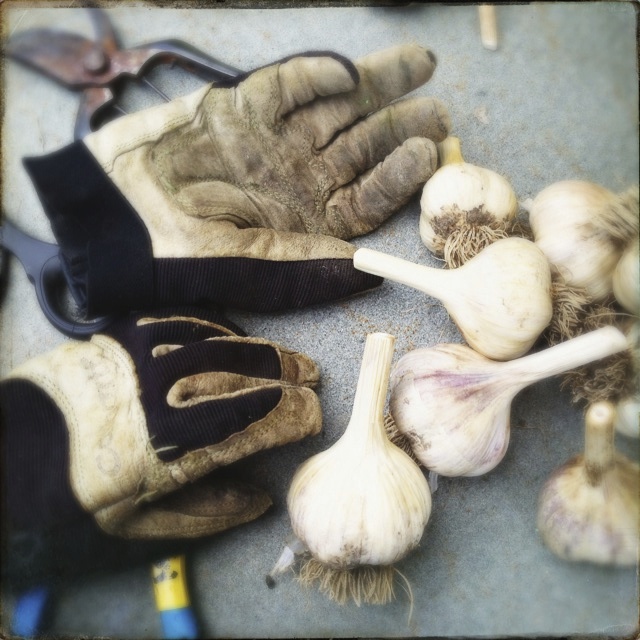







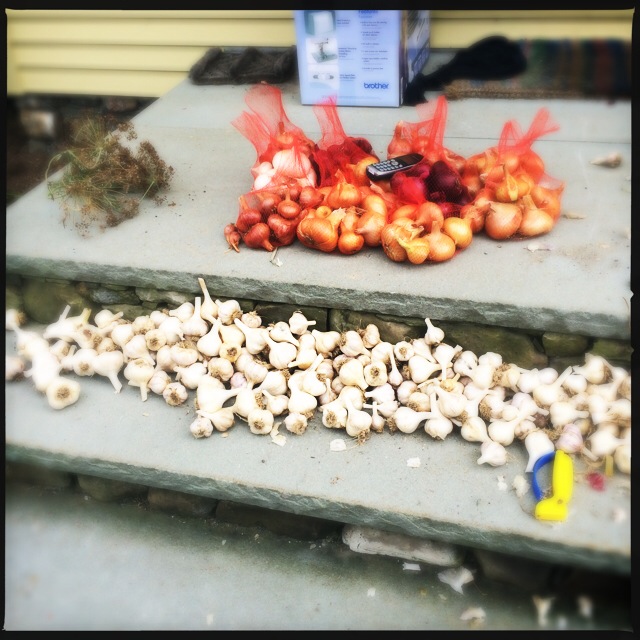




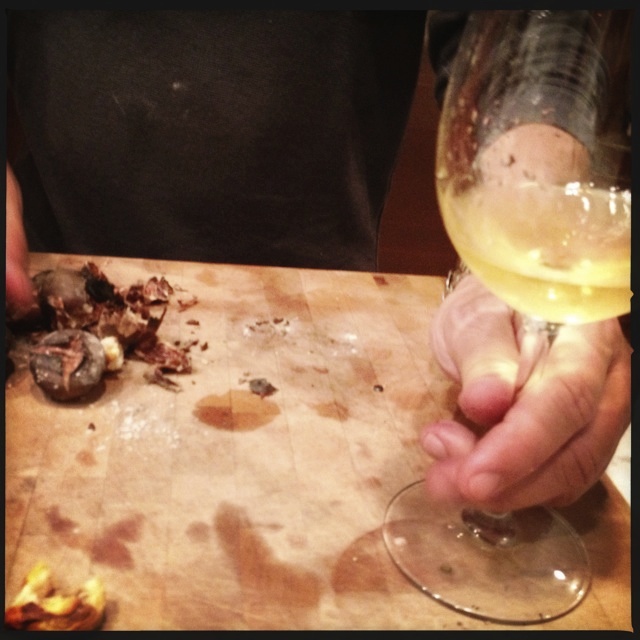

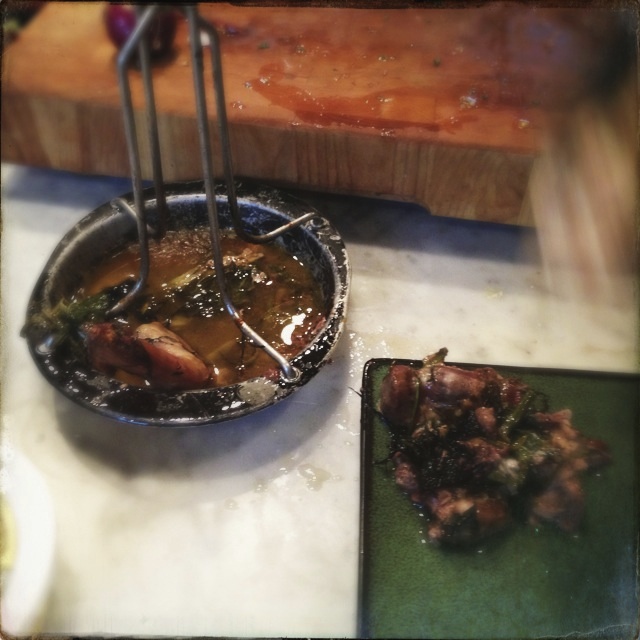
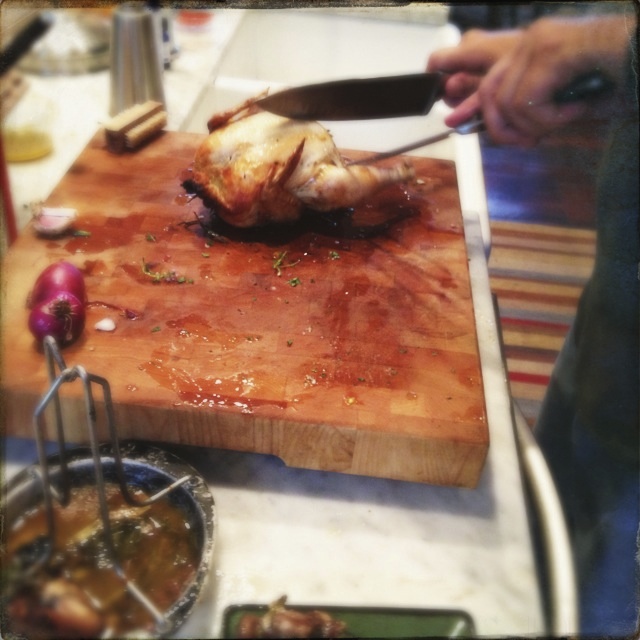
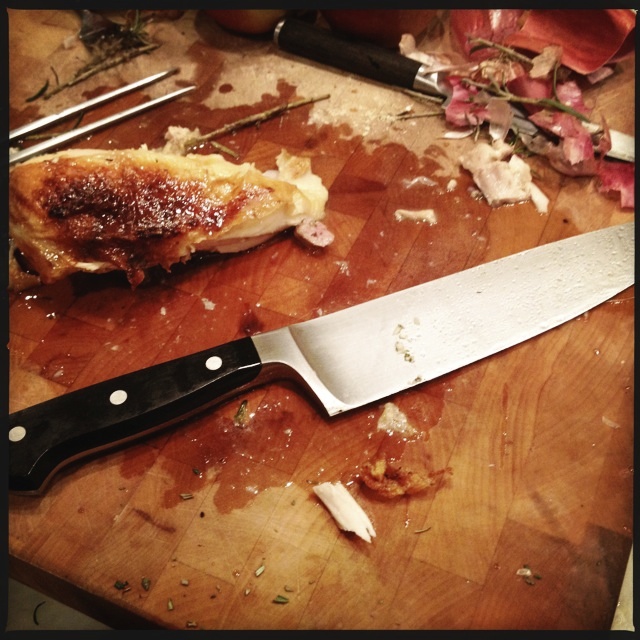








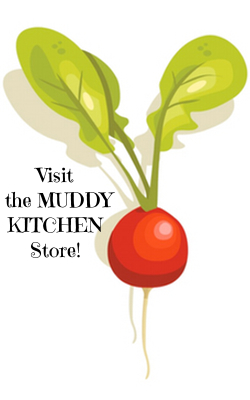
{ 5 comments… read them below or add one }
Hello Old Friend! Home grown garlic (nothing better in this world)…and lardo, you are a true romantic! And your chicken, roasted, looks so, so loved! xo from Wisconsin:)
solow is back!
must be spring…
There is simply no substitute for fresh home grown garlic. LOVE IT…oh and the author too…
My favorite blog by far!
I second that Nigel! Woo Hoo! My fav blog by far too Tom!
Wow. Garlic never looked so beautiful. Love the story and photos….this add a whole new dimension to the garlic you brought to the office. Thanks!